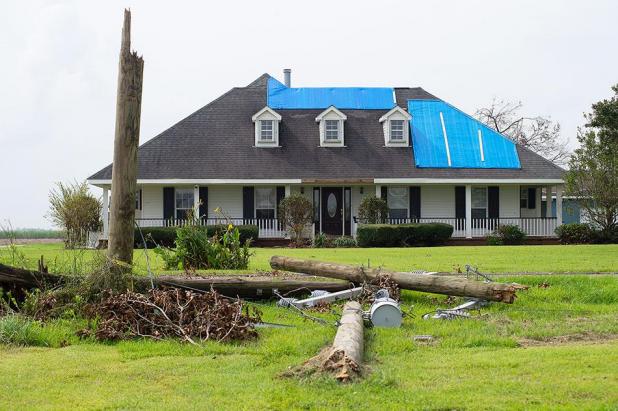
Downed power lines lie near a house with blue tarps on the roof after Hurricane Ida in St. James Parish on Sept. 8.
—LSU AgCenter/Olivia McClure
Blue tarp blues? Get a hurricane-hardy roof
BATON ROUGE — Singing the blue tarp blues is no joke. If your home’s roof was damaged by Hurricane Ida, it doesn’t have to happen again. There are now roofing products and methods that can withstand a category 4 hurricane.
The key is to specify the right types of products and installation methods, according to Claudette Hanks Reichel, LSU AgCenter housing specialist.
Homeowners insurance in hurricane zones normally has a large deductible for damage from a named storm, resulting in a large out-of-pocket expense to restore your home. The cost of an upgraded roofing system to avoid future hurricane damage is an exceptionally wise investment — saving you money, hassle and potential displacement from your home because roof and water damages.
Take control of your future by specifying the following hurricane-hardy roof guidelines and by selecting a licensed or registered roofing contractor who is willing to implement them. The guidelines after the first two steps apply to both new roofs as well as roofing replacements.
For more detailed information to provide to your roofing contractor, get the Fortified Reroofing Checklist at fortifiedhome.org/standards. Fortified Roof is a designation program of the Institute of Business and Home Safety, and the program’s guidelines are research based. Some insurance companies even offer premium discounts for verified Fortified Roofs.
When re-roofing, remove all the existing roof covering. Do not add new shingles on top of old shingles. Reichel recommends these 10 additional steps to get your roof hurricane-hardy:
1. Examine the roof decking for damage and make sure it is at least 7/16 inch thick. Replace damaged wood. If replacing the entire deck, consider upgrading to 5/8-inch plywood for a stronger roof.
2. Reinforce roof decking attachment to roof framing with 8d ring shank nails (at least 0.113 inch diameter, 23/8 inches long with full round head) spaced every 6 inches, plus every 4 inches along gable ends. Do not fasten roof decking with staples or screws.
3. Add a secondary moisture barrier to prevent water leaks at decking seams if roofing is ever lost or damaged. This can be achieved by taping the panel seams with a 4-inch wide adhesive flashing tape approved for use on roofs. Do not use window flashing tape.
4. Properly install new, durable flashing at all penetrations, roof and wall intersections, and valleys. Proper installation methods layer materials shingle-fashion to prevent water seepage under flashings. When a roof slope intersects a side wall, step flashing is best practice. The commonly used continuous turnback “L” flashing is less robust in shedding heavy rain, and it creates a dimple in shingles that can catch wind.
5. Upgrade the underlayment. Choose tear-resistant No. 30 synthetic underlayment, or for greatest protection, install an adhesive membrane (peel and stick) underlayment on the entire deck with a roofing felt layer over it as a bond break to simplify future shingle removal (no need for taped seams with membrane underlayment).
6. Install new drip edge over the underlayment and fasten every 4 inches to hold down the underlayment’s edges during high wind. Along the roof eave, flashing cement or tape at the top of the drip flashing is a good added measure to prevent water seepage under it.
7. Select a wind-tested roofing rated above the local building code wind speed. Visit www.lsuagcenter.com and search for “wind hazard zones” to find your location’s wind speed. For shingles, use at least Class F (ASTM D3161), or choose Class H (ASTM D7158 tested to 150 mph) for highest wind resistance.
Note that shingle lifespan warranties (in years) are not an indicator of wind resistance, so a high-end 40-year architectural shingle that is not wind-rated is not made to withstand high wind and may not perform well in a hurricane.
8. The wind-rated roofing must be installed strictly according to the manufacturer’s high wind instructions. High wind-rated shingles usually require a matched starter strip that has strategically placed adhesive (not a trimmed or upside-down shingle as the starter) and six nails per shingle at specific spots in order to perform as tested and be warranted.
9. Even the highest wind-rated shingles can fail if the roofing nails are improperly placed. Overdriven nails penetrate rather than hold the shingles in place. This failure is common with the use of hydraulic nail guns to install shingles. By hand nailing, roofers can ensure the nail is properly placed flush with the shingle. Insist on hand nailing in your roofing bids.
10. If your home has a vented attic, use only TAS 100(A)-tested ridge or roof vents. Securely fasten strong panels and soffit vents to the framing under roof overhangs. Perforated fiber cement soffits are a sturdy, one-step, low-maintenance option.
Learn more about resilient, high-performance home construction and restoration by visiting the LSU AgCenter LaHouse Resource Center website at www.lsuagcenter.com/LaHouse.
LaHouse Resource Center, located on the LSU campus, is an educational showcase of solutions for the southern climate and natural hazards. It is open for self-guided tours; masks are required. Or you can see video tours and videos about its building systems and home improvement topics on the LaHouse YouTube channel at www.youtube.com/myLaHouse.
